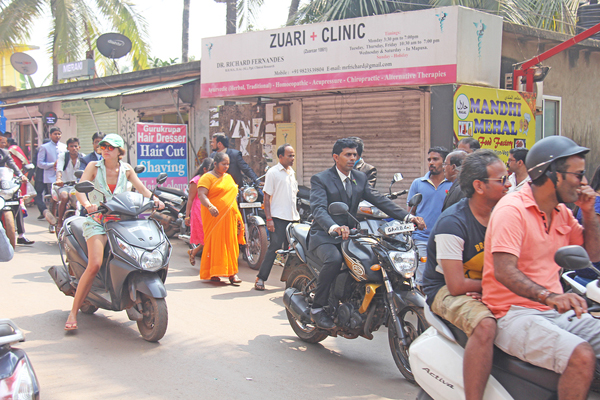Guide to Residency in India
Summary: Looking for guidance on obtaining residency in India? Discover the steps involved and read advice from digital nomads. nomads, and others already in India.

Obtaining a residency visa in India is not always easy, but our Guide to Residency in India gives newcomers an overview of the steps involved and advice from others who have already navigated the process.
- Research Indian Visa Types
- Visit the official Indian visa website: Indian Visa Online.
- Determine which type of visa applies to your situation (e.g., Employment Visa, Entry Visa, Business Visa, etc.).
- Understand the eligibility criteria and requirements for the chosen visa type.
- Apply for an Appropriate Visa
- Complete the online application form on the Indian Visa Online portal.
- Upload necessary documents, such as passport, photograph, and any additional supporting documents based on the visa type.
- Schedule an appointment for a visa interview at the nearest Indian consulate or embassy.
- Pay the visa application fee, which varies depending on the type of visa and the applicant's nationality.
- Attend Visa Interview
- Prepare for the interview by gathering all original documents and any additional information that may be required.
- Attend the interview on the scheduled date and time.
- Answer all questions truthfully and provide any additional information the consular officer may request.
- Obtain the Visa
- Wait for the processing of your visa application. Processing times can vary.
- Check the status of your visa application online using the application ID provided.
- Once approved, collect your passport with the visa stamp from the embassy or consulate, or have it mailed to you if that service is available.
- Travel to India
- Book your travel to India after receiving your visa.
- Ensure you have all necessary documents for entry, including your visa and passport.
- Register with the Foreigners Regional Registration Office (FRRO)
- Visit the FRRO website: FRRO Online Services.
- Complete the online registration within 14 days of arrival in India if your visa type requires it (e.g., Employment Visa, Student Visa).
- Schedule an appointment and visit the nearest FRRO office with all required documents.
- Apply for a Tax Number (PAN Card)
- Visit the official PAN card application website: NSDL PAN Services.
- Fill out Form 49A for Indian citizens or Form 49AA for foreign citizens.
- Submit the form along with the required documents, such as a copy of your passport and visa.
- Pay the application fee and submit the application.
- Track the status of your PAN card application online.
- Once issued, the PAN card will be mailed to the address provided in the application.
- Apply for Residency Status
- Consult with an immigration lawyer or a consultancy specializing in Indian immigration for advice on applying for residency.
- Understand the eligibility criteria for residency, which may include a certain number of years of stay, employment status, or investment in India.
- Prepare and submit the necessary application and supporting documents to the relevant Indian authorities.
- Attend any required interviews or appointments as part of the residency application process.
What tips do digital nomads and expats have about residency and visas in India?
"The process of applying for a visa in India depends on the type of visa you are applying for. Generally, you must complete an online application form and submit copies of required documents, such as a passport, valid passport-sized photos, bank statements, and an authorized travel itinerary. You may also need to provide medical or employment documents, or proof of a valid Indian visa, depending on the type of visa you are applying for. If you are applying for residency in India, you must first obtain a valid visa, such as business or employment visa, or a spouse visa if married to an Indian national. Once you have the necessary visa, you are required to apply for a Resident Permit before you can reside in India for more than six months. To do so, you must submit an application form and copies of your passport, visa, address proof, bank statements and marriage certificate (if applicable) to the Foreigners Division of the Regional Passport Office. The Indian government then issues the Resident Permit," commented one member living in India.
About the Author
 Joshua Wood, LPC is one of the Founders of Digital Nomad Exchange and serves as Co-President of Expat Exchange. Prior to Expat Exchange and Digital Nomad Exchange, Joshua worked for NBC Cable (MSNBC and CNBC
Primetime). Joshua has a BA from Syracuse and a Master's in Clinical and Counseling Psychology from Fairleigh Dickinson University. Mr. Wood is also a licensed counselor and psychotherapist.
Joshua Wood, LPC is one of the Founders of Digital Nomad Exchange and serves as Co-President of Expat Exchange. Prior to Expat Exchange and Digital Nomad Exchange, Joshua worked for NBC Cable (MSNBC and CNBC
Primetime). Joshua has a BA from Syracuse and a Master's in Clinical and Counseling Psychology from Fairleigh Dickinson University. Mr. Wood is also a licensed counselor and psychotherapist.
Some of Joshua's articles include Pros and Cons of Living in Portugal, 10 Best Places to Live in Ireland and Pros and Cons of Living in Uruguay. Connect with Joshua on LinkedIn.

Get a quote for international health insurance from our partner, William Russell.
Get Quote
 William Russell
William RussellGet a quote for international health insurance from our partner, William Russell.
Get Quote
![]() India Forum
India Forum
Talk with other digital nomads and expats in India on our India forum - meet people, get advice and help others.
![]() Contribute
Contribute
Help others in India by answering questions about the challenges and adventures of living in India.
Digital Nomads in India offer advice about healthcare, hospital visits, emergency rooms visits, finding a doctor and buying health insurance in India.

 India
India

